Sunday morning. The family dispersed all over the world. Our son works as a ski instructor in Canada, Our daughter revisits Kenya on her vacation and my wife hangs out with friends in France. Time to get something done.... Like a new post here!
The electrical parts for the bike are soon complete. A couple of days ago another missing piece arrived from the US. The fuse holder. I know it is ridiculous to hunt for NOS parts when you can put most any fuse holder on here, but I need it to be as correct as I can get it. Now I need to fix some wiring, clean up a set of used ignition coils I found on eBay (these are for the H1 street bikes, but I believe they will work here as well), clean up the stator and replace the points and the condensers (have them!) and finally get a good rectifier. I have a couple of them on watch on eBay.
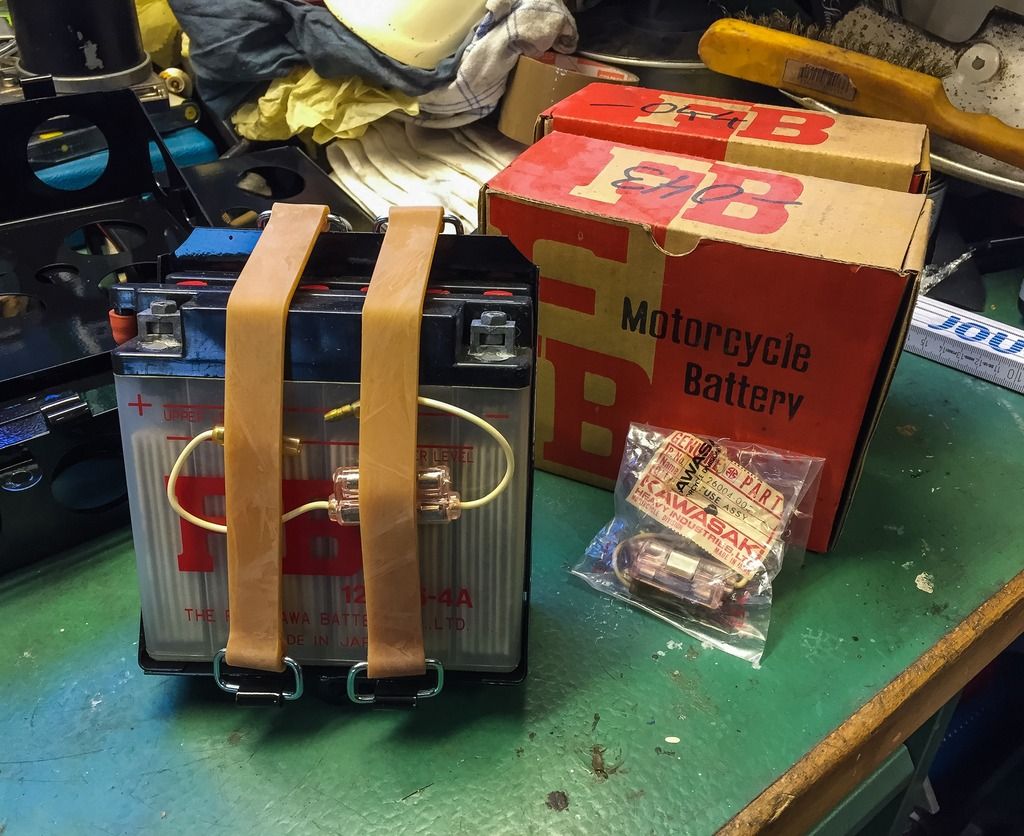 |
| NOS fuse holders arrived! |
My post on the battery boxes raised a few eyebrows over the world. Why would you make 6 of them when you need only one and the worldwide market probably needs a maximum of 3...?
Hard to tell... I´m a bit of a romantic, I suppose, and having enough rubber straps for even more of them made the decision natural. Anyway, I´m pleased to tell you I made a deal with one of them!
A friend from France needed one of the boxes and he had a set of KONI rear shocks that I was looking for to my bike. Such a perfect trade. Thanks a lot Francis!!
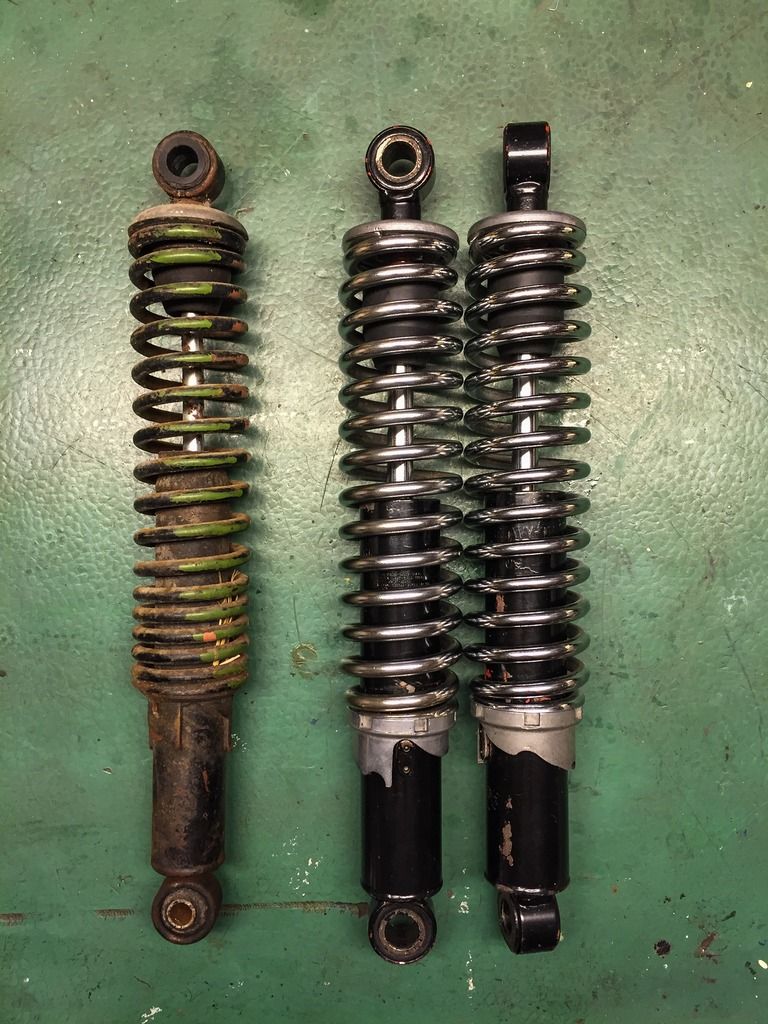 |
| Girling vs Koni. |
These will fit like a charm as replacement of the shot Girlings that was on the bike. I think I´ll try to change the top spring holders between the shocks and get that slightly "rounded" look that the original shocks from Kawasaki had. I know this is a step away from what "Esso" used but tatty old Girlings just won´t cut it. Getting the originals (45014-052) seems to be impossible.... Or do YOU have a set??
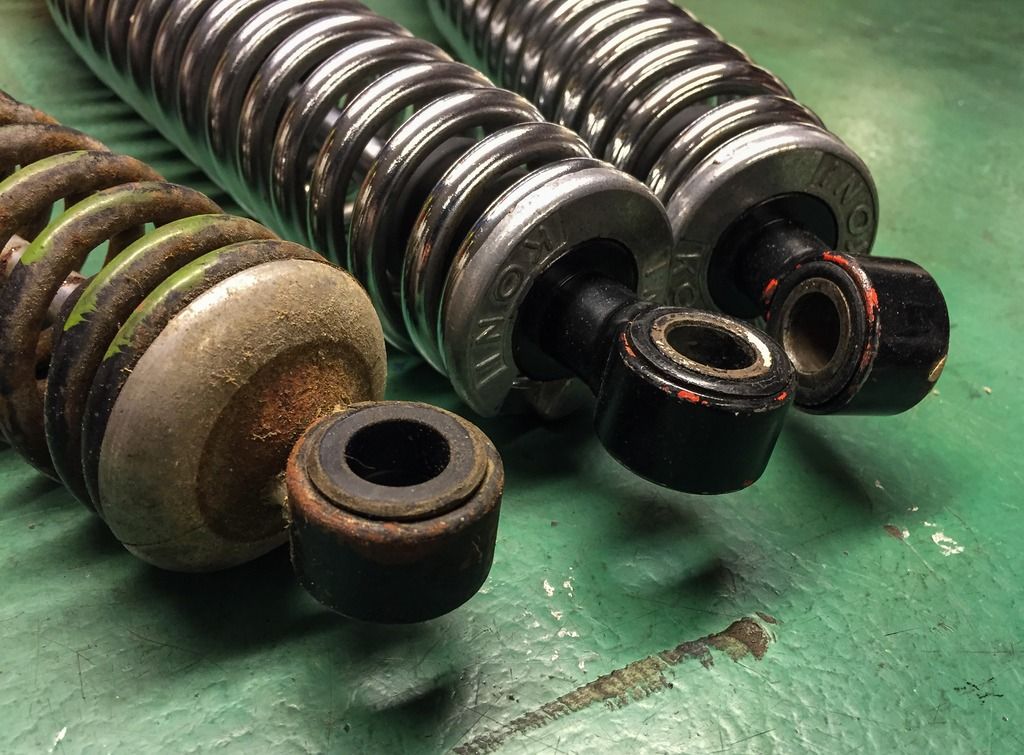 |
| Changing top spring holders? |
This is one of the major problems solved... Nice!
Time for a little fettling with some small parts on the bench! Let´s have a look at that front brake cable....
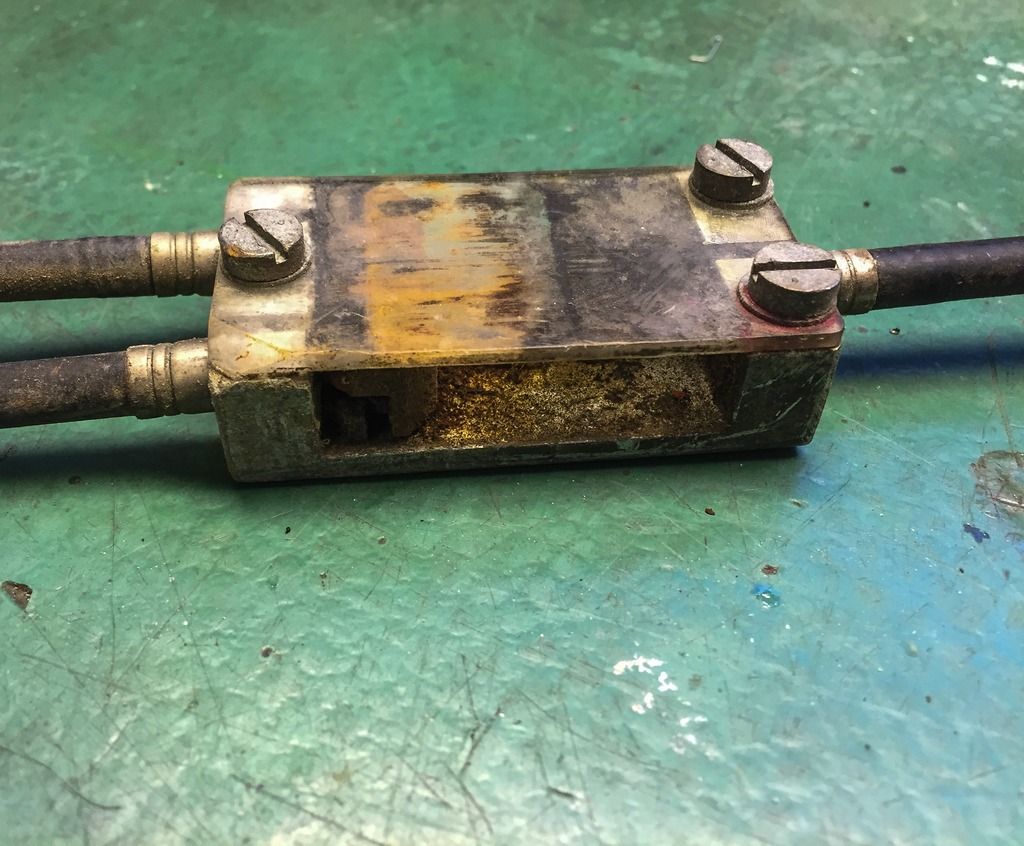 |
| Needs a bit of cleaning?! |
The cables look OK, just needs some TLC, greasing and cleaning, to work fine. The "splitter" above is another story. Full of dirt and saw dust (?) it had to be taken apart and cleaned more seriously. It is also obvious that someone, someday, have been working on this. The fasteners are not the original "pan head" screws from Kawasaki, but some nice "flat screw driver" screws from any machine shop in Sweden 1971... And I like it! It would have been easy to fit the correct screws from my stock but I will keep these oddballs in the interest of authenticity and in honor of the men working to keep it racing back in the day!
*** EDIT! My Canadian friend Aaron and Janne W. here in Stockholm have confirmed that their bikes also have these screws on the brake splitter... Seems like they are original after all! END EDIT***
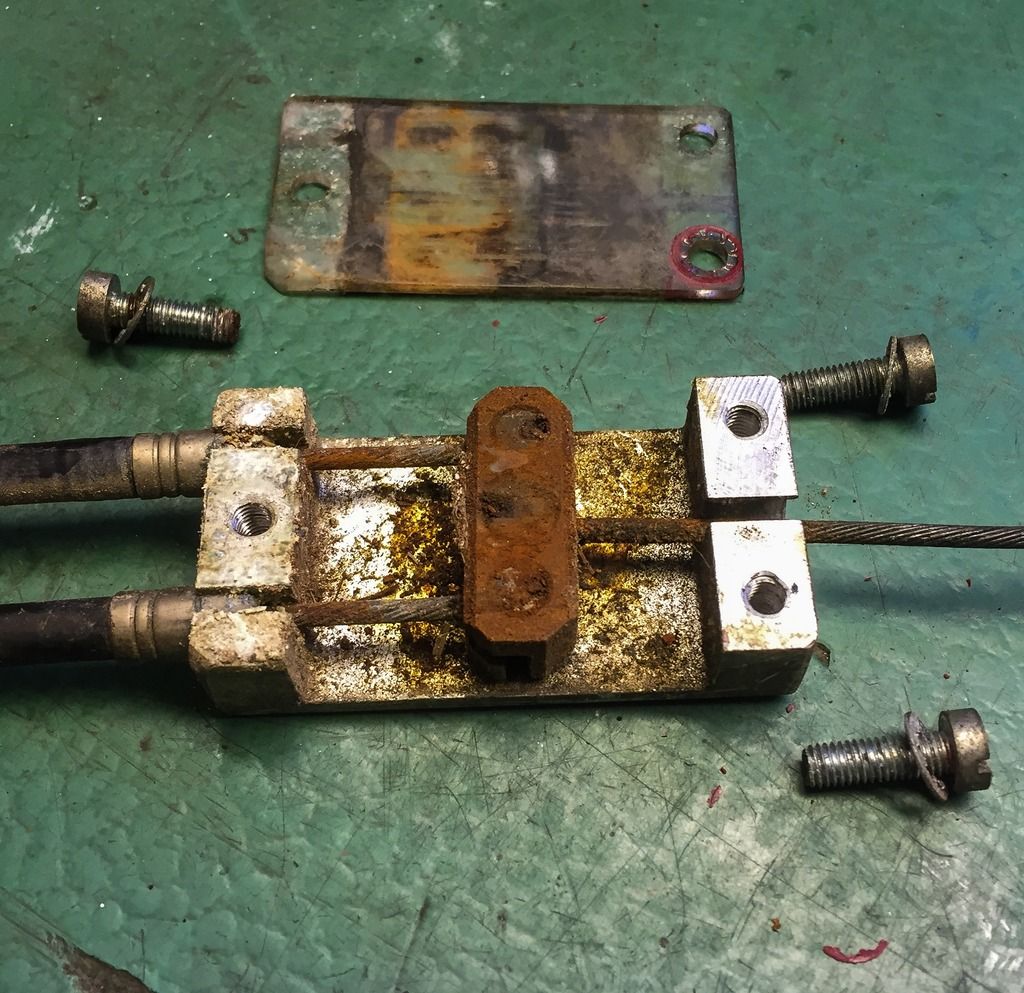 |
| Rust..... |
As you can see here, the internals of the "brake balancer" was seriously corroded and rusty. these parts had to soak in penetrating oil over night before they would come apart.
That is one of the perks with having your own garage in the house. Just leave it and get back up to the family in one minute...
Watching TV or having dinner I was thinking about these parts. Didn´t I buy something like this many years ago for another project? I was working on a set of front 4LS brakes from an old Suzuki GT750 1972 and tried to solve the problem with having two cables from the wheel become one at the handlebar... Now, where did that little thing go?
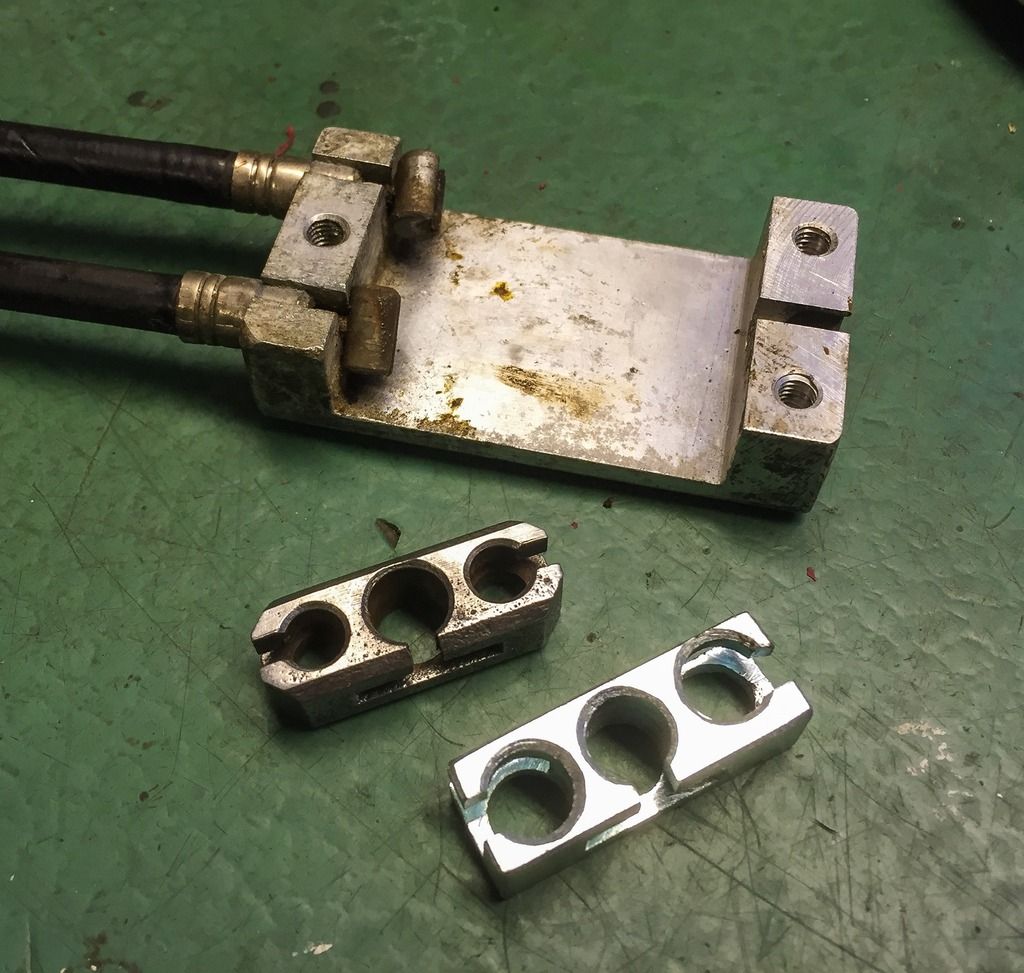 |
| Found it! |
Yes! I remember buying this little gem from England. It is a copy of the same part for a Yamaha TZ350 with dual front drum brake. The parts are almost identical. Same outer measurements, the only difference is the hole diameter for the brake cables "bosses" or lugs. These are larger on the Yamaha part. An easy fix if you´re going to build your cables. I´m not, so the Yamaha part goes back in the box...
Ok, the evening after the cleaning continued... I treated the cables with 5-56 (penetrating oil) and let them soak in ordinary lubricating oil for a while. That smoothed out everything. working as new! It´s great to be able to reuse what´s already on the bike. This is especially true since finding parts are more or less impossible... Below is a picture of the lower end of the cables. Just needed a good clean and lubrication to be OK. Note the cotter pins that allows you to safely turn the adjusters without turning the cables or separating the cable sheaths from the adjusters? Never seen that on the street bikes.
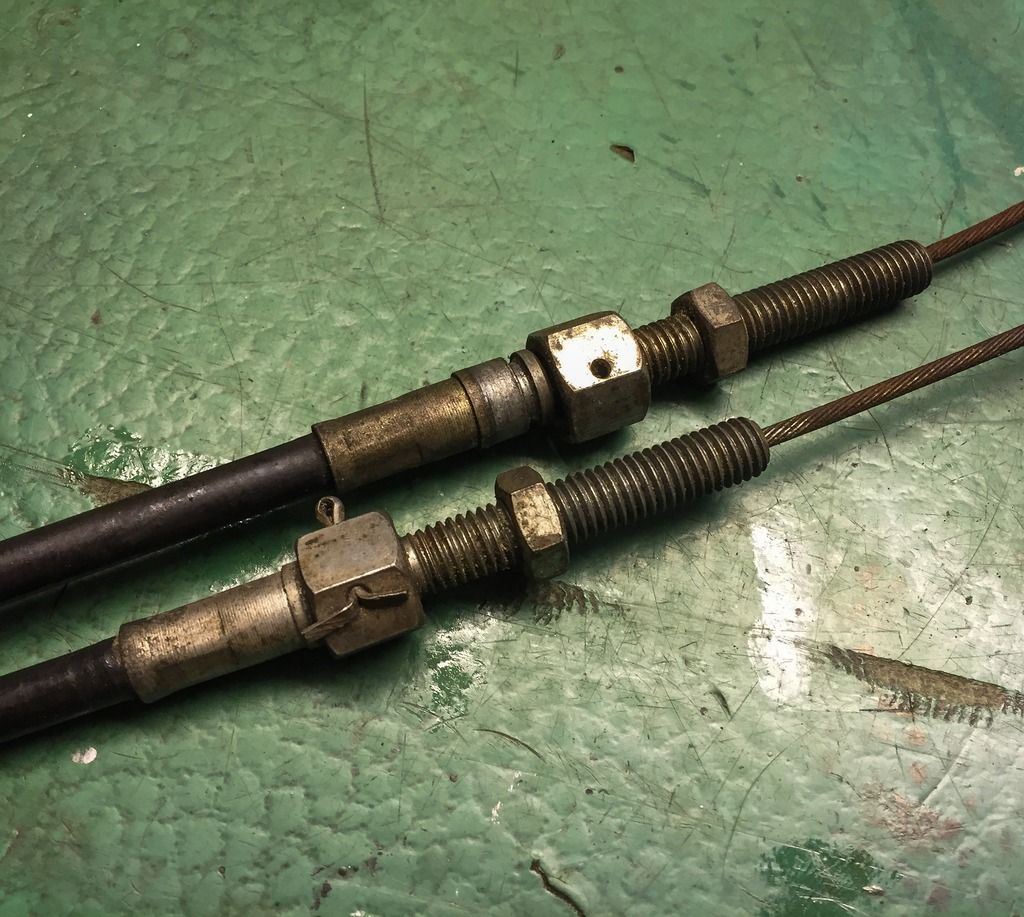 |
| bottom ends of the cables. |
A couple of hour worth of time and the front brake cable was ready to install... In all its glory with the "wrong" fasteners and a bit of scratched plastic etc, etc. Just the way i like it!
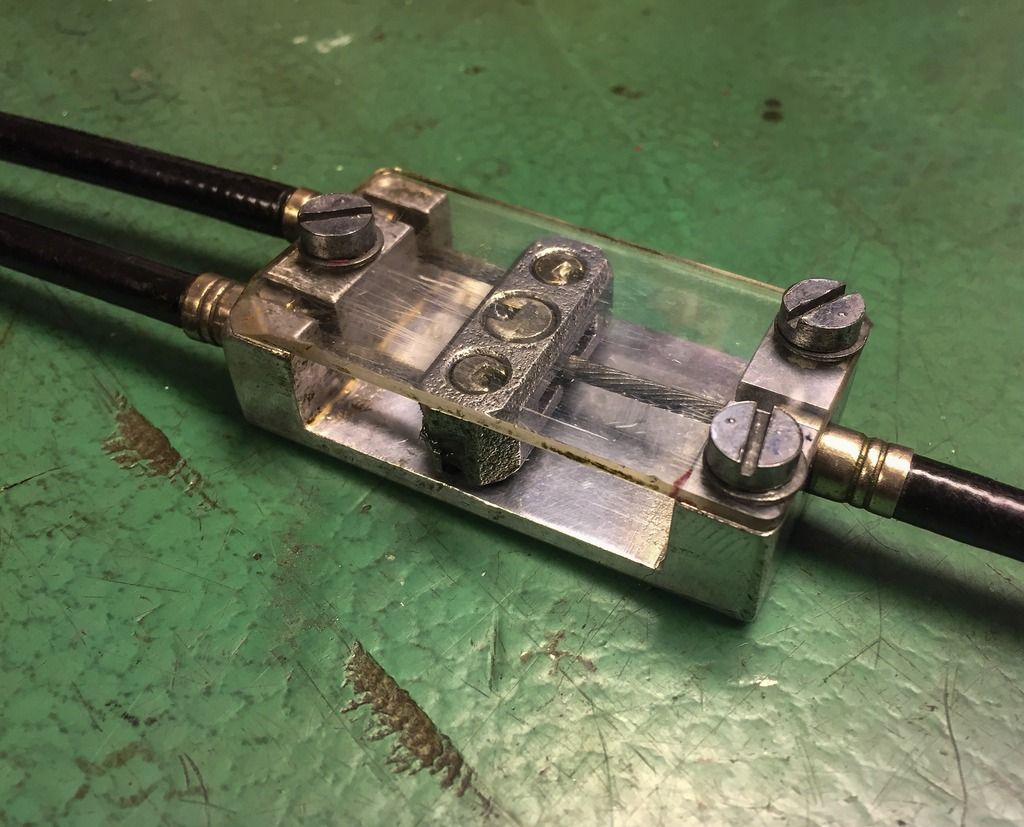 |
| Ready to install. |
I couldn´t resist polishing the housing a little bit. I need it to look nice also. Even the back side has to be presentable.
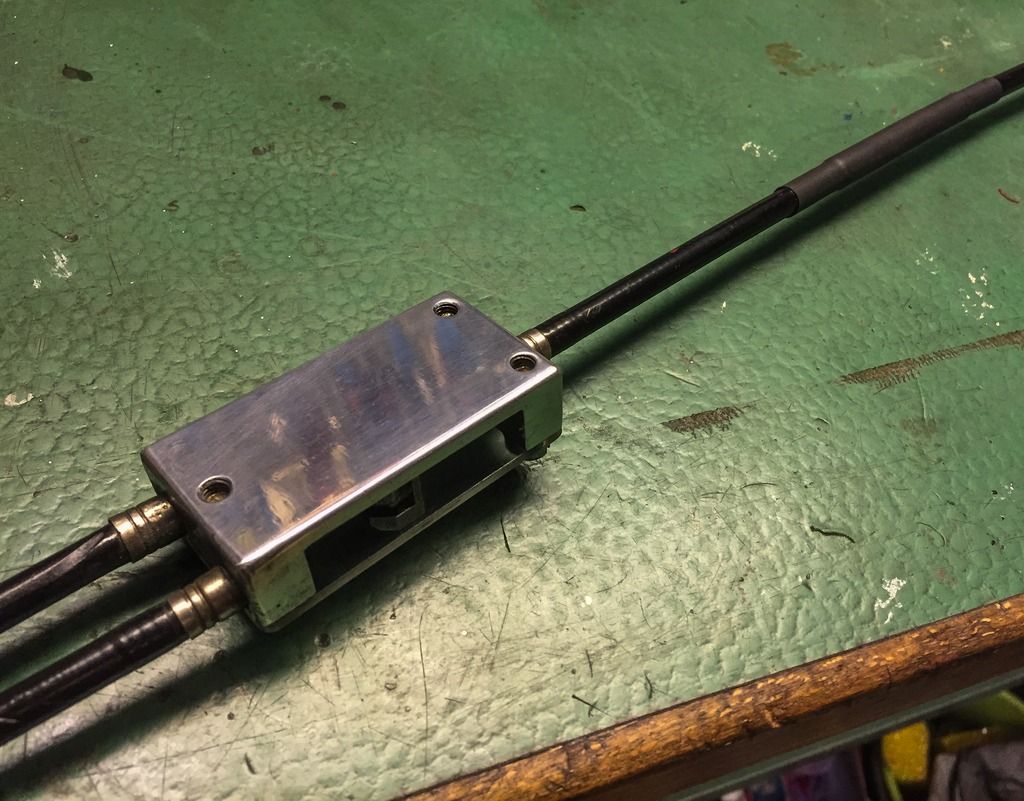 |
| Shiny back side. |
In this picture you can see I put some heat shrinking tube on to the cable sheath. There was a damage right there from rubbing against the frame or something. A couple of layers of extra protection will prevent further deterioration of the cable. An addition in the name of functionality.
A couple of nights work on old stuff finally rendered me a fully usable front brake cable!
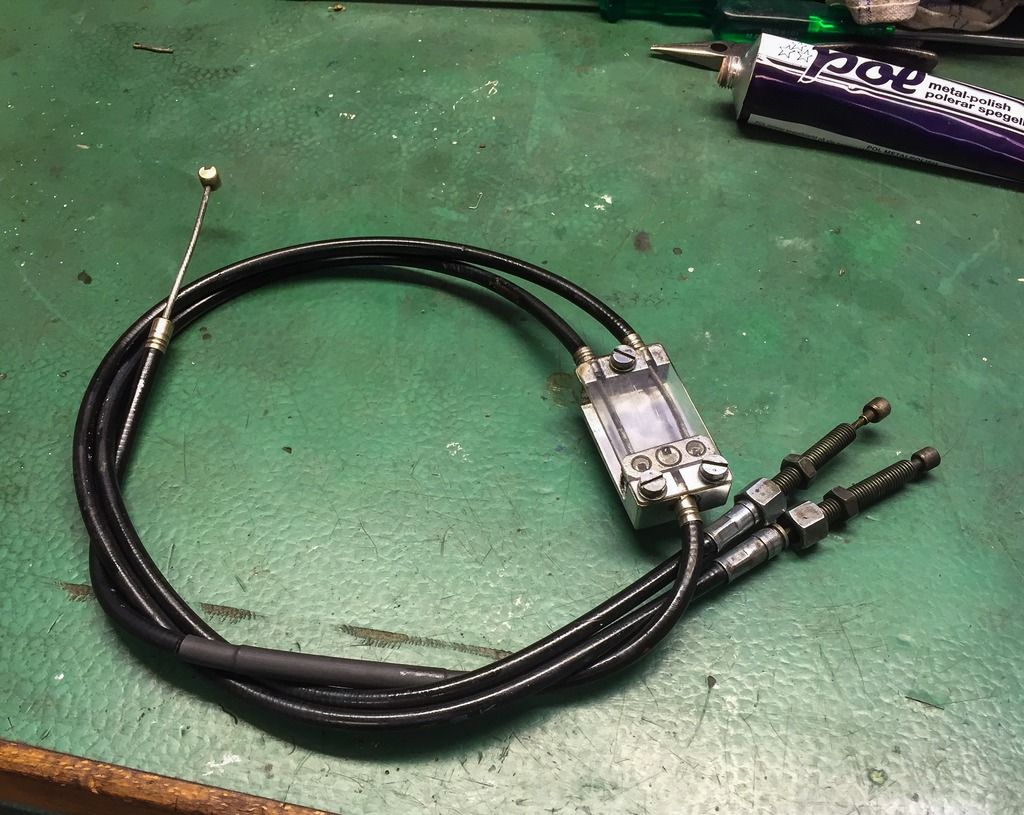 |
| Old, but fully usable! |
I finally received the front fork inner tubes from Germany. The seller on eBay made a mistake and sold me a set without having them in stock at the time. Not very good, but I got them later at a very nice price as compensation. The power of feedback is enormous when you buy or sell on eBay! Be very polite and never threaten to post negative. You don´t have to! Every seller knows what negative feedback does to your business...
The story behind this purchase is a tip from Malcolm in Britain stating that the front fork inner tubes from a Yamaha RD250 1973-75-ish would be close enough to re-manufacture to fit the H1R. He couldn´t be more specific but I´m no coward when it comes to shopping! So I got a set just to find out. I mean, what could possibly go wrong? Worst case scenario would have me with a pair of Yamaha RD front fork stanchions for sale... No big deal!
The tubes are from the Italian maker TNK and look awesome! Count on approx 300 euros for a set.
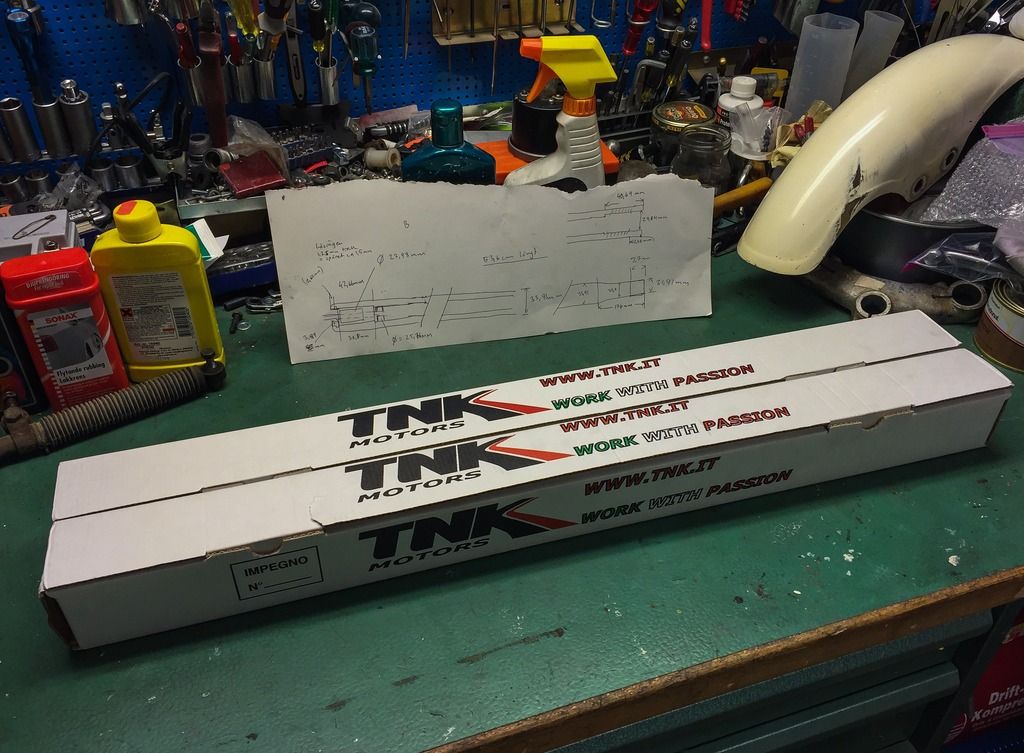 |
| Italian qulity! |
OK, now it´s time to see if this will work or not... You can see my scribblings behind the boxes. That is my measurements from the original tubes.
Too bad I can´t compare directly because I left the originals for grinding the other day. I had a few options when it came to restoring the stock tubes and finally decided to go local. No shipping to England, No hydraulic firm in Skellefteå. I´m using local firms here in Stockholm. The grinding/polishing will be done by B.L Slipteknik in Jordbro, Stockholm, and the hard chrome will be supplied by Fintlings in Solna. That process is in full swing!
Back to the re-manufacturing of copies...
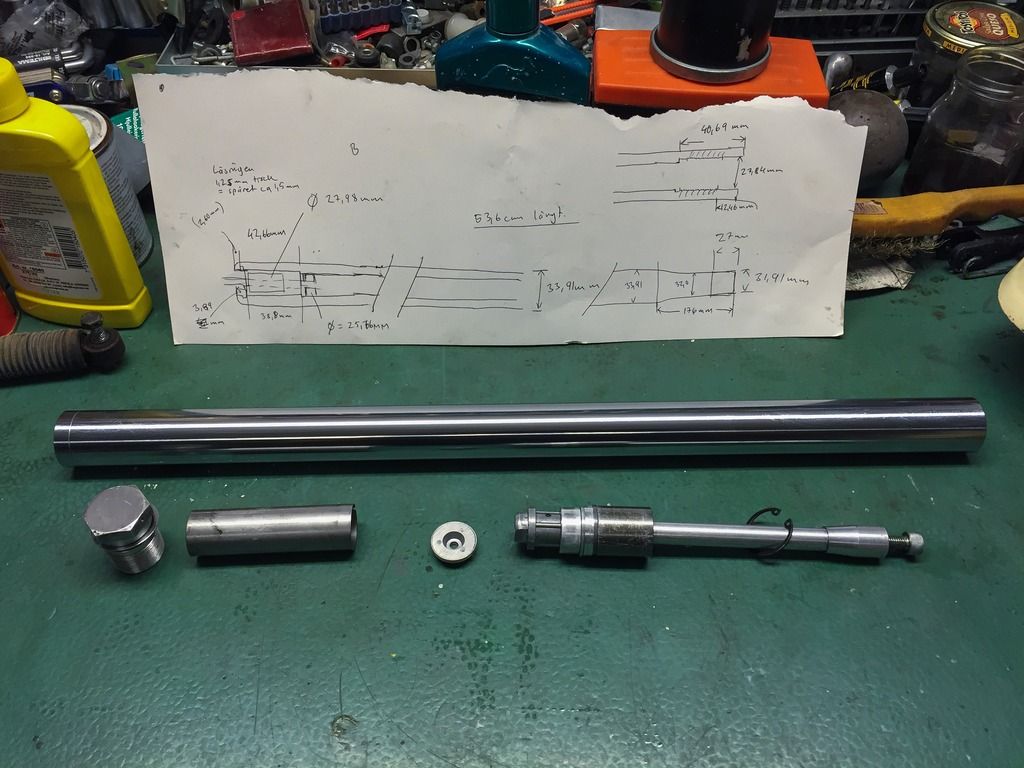 |
| Will this work out? |
The TNK tube is ca 5 mm longer than the stock tube. I don´t see that as a problem at all! A 5mm extra washer inside will take up any potential spring slack or I will have them cut to the exact length. What´s more important is the internal design. Will the hydraulic damper unit fit inside the tube?
Will the top bolts fit inside the tube at the top? Thread the same?
The latter questions were easily checked. They did, straight in, all the way in and fit perfectly!
Before I bought the set I looked all over the internet in search of measurements and found what I needed. The outer diameter is the same, 34 mm. The inner is also the same, 26 mm. The surface and quality of the inner surface was the reason I could´t find someone that could make the tubes from scratch. The inner side of front fork stanchions are highly polished to seal together with the damper. These looked and measured OK! I measured the stock tubes thoroughly and made the drawing you can see above the tubes. Everything looked fine. Why not just try it...??
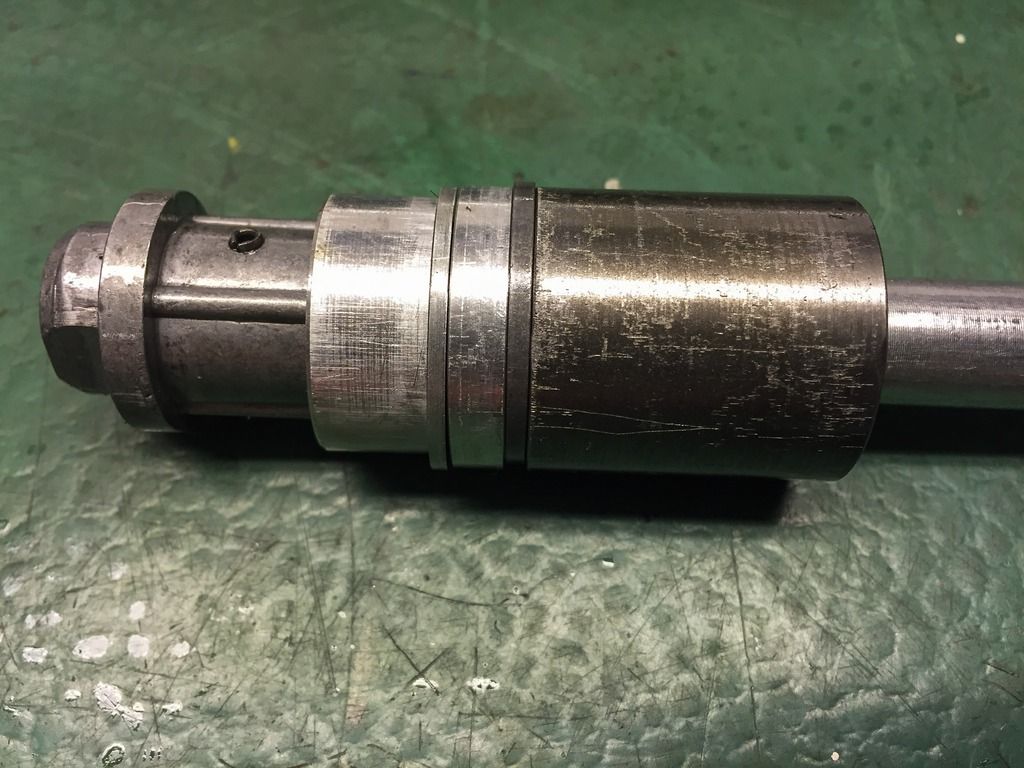 |
| Front fork internals. |
These hydraulic dampers sit inside the tubes. The left aluminium parts with the slightly smaller diameter fits inside the 26mm polished tube and the slightly larger diameter washers and aluminium and steel oil dampers sit lower inside the tube in a milled area furthest down, locked in place by a circlip. The size (lenght) of the milled area and the circlip groove size are critical....
In this picture you can see what I´m mumbling on about...
 |
| Inside of lower fork tube. |
The diameter and length of the milled area seems to be OK, as does the circlip groove. The only thing I can see down here that might pose a problem is the shape of the lower end of the tube. The originals have a more "rounded" shape at the bottom. I think that´s an easy fix if the rest is solved. Let´s see!
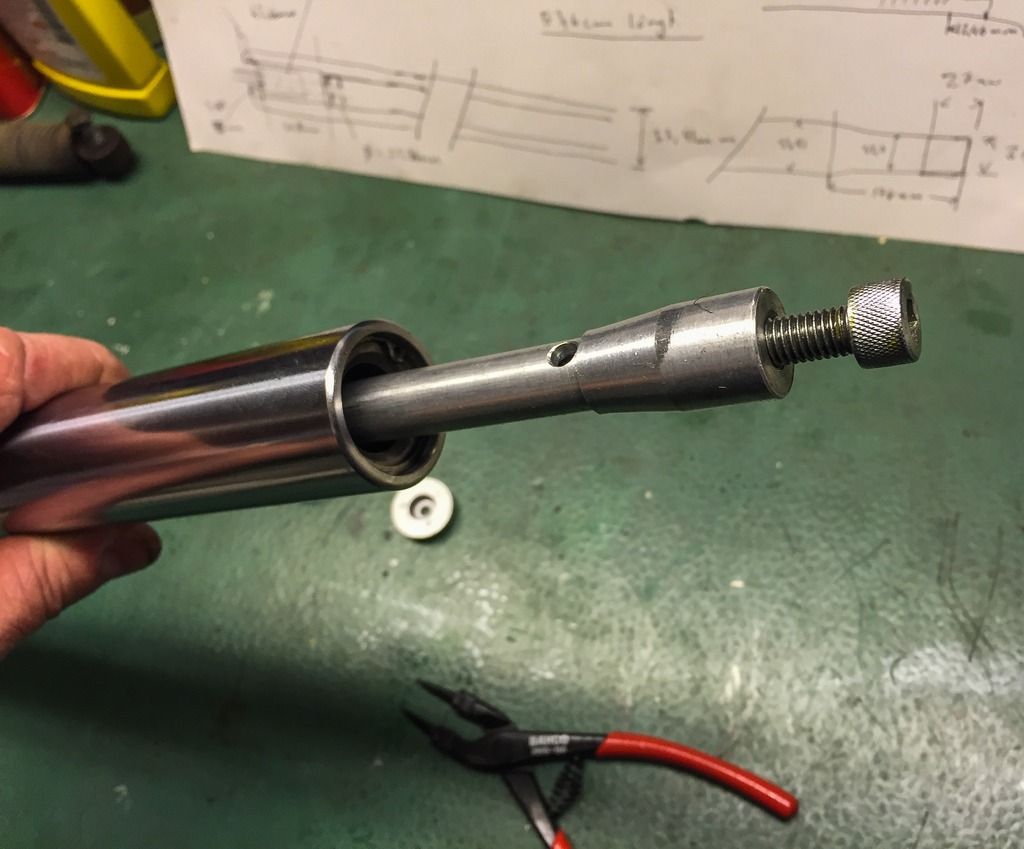 |
| Fits right in! |
Heureka! That fits like a charm! Absolutely no machining required on the inside of these tubes, that is for sure. The circlip fits tight and snug and the length/diameter of the milled area seems perfect. I´ll double check all of this when I get the original tubes back. Seems like I have confirmed this to be true! RD250 1975 inner tubes takes Kawasaki H1R inner hydraulic parts straight in! I will still have to get the outside of the tubes milled in the top, outer section. Remember the tubes are smaller in diameter at the top yoke? 32 mm there compared to 34 mm at the lower triple tree. That´s going to be an easy fix for any mechanical workshop. I´ll do that when I have the originals ready to use as master.
Fun as it is writing and fixing with this bike I have other obligations... Work takes its toll these days. New challenges and courses I have to attend to, has me trapped with manuals, procedures and checklists to go through. An hour here and there in the garage or by the computer posting stuff here makes life a lot easier and much more fun!
The next post will be preparing the frame for media blasting and paint...
Stay tuned!
/Per














